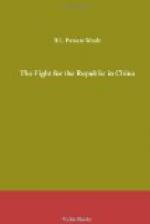The study of twenty years of history proves this assumption to be correct. Ever since 1895, Japan has been driving wedges into the Yangtsze Valley of a peculiar kind to form the foundations for her sweeping claims of 1915. Thus after the war with China in 1894-95, she opened by her Treaty of Peace four ports in the Yangtsze Valley region, Soochow, Hangchow, Chungking and Shasi; that is, at the two extreme ends of the valley she established politico-commercial points d’appui from which to direct her campaign. Whilst the proximity of Soochow and Hangchow to the British stronghold of Shanghai made it difficult to carry out any “penetration” work at the lower end of the river save in the form of subsidized steam-shipping, the case was different in Hunan and Hupeh provinces. There she was unendingly busy, and in 1903 by a fresh treaty she formally opened to trade Changsha, the capital of the turbulent Hunan province. Changsha for years remained a secret centre possessing the greatest political importance for her, and serving as a focus for most varied activities involving Hunan, Hupeh, and Kiangsi, as well as a vast hinterland. The great Tayeh iron-mines, although entirely Chinese-owned, were already being tapped to supply iron-ore for the Japanese Government Foundry at Wakamatsu on the island of Kiushiu. The rich coal mines of Pinghsiang, being conveniently near, supplied the great Chinese Government arsenal of Hanyang with fuel; and since Japan had very little coal or iron of her own, she decided that it would be best to embrace as soon as possible the whole area of interests in one categorical demand—that is to claim a dominant share in the Hanyang arsenal, the Tayeh iron-mines and the Ping-hsiang collieries. [Footnote: The reader will observe, that the expression “Hanyehping enterprises” is compounded by linking together characters denoting the triple industry.] By lending money to these enterprises, which were grouped together under the name of Hanyehping, she had early established a claim on them which she turned at the psychological moment into an international question.




